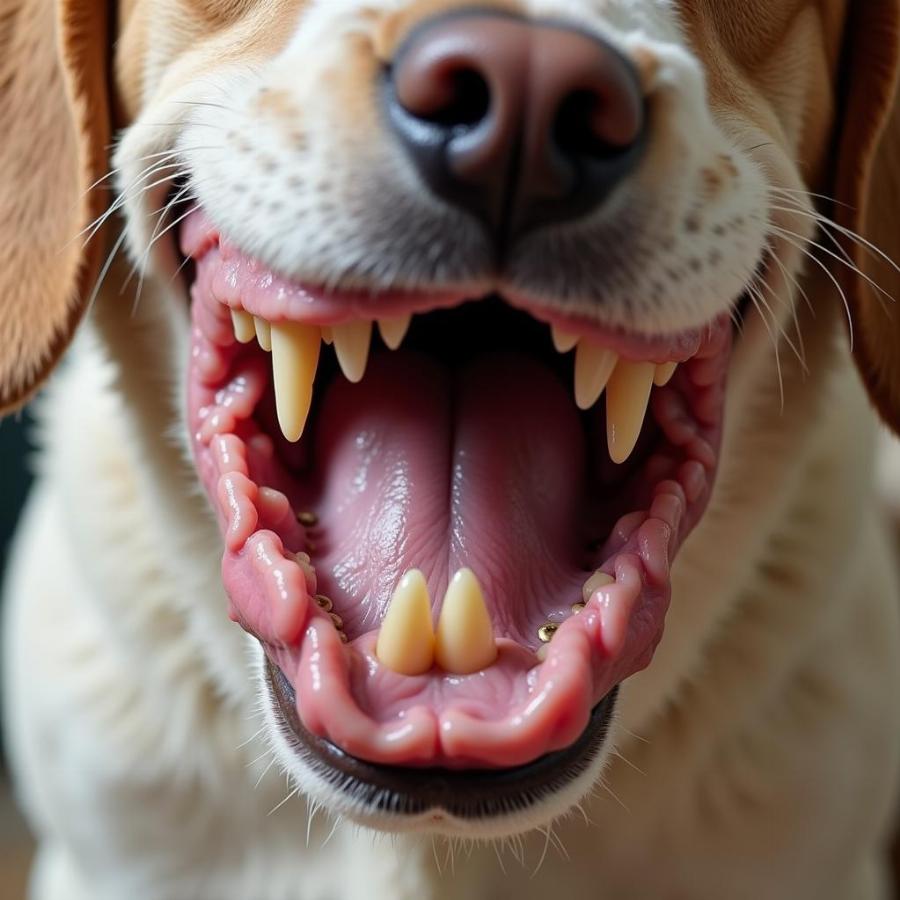Gum health is a crucial aspect of a dog’s overall well-being, and understanding the role gum plays in their health is essential for every responsible owner. This article explores the connection between gum and dogs, covering everything from common gum issues to preventative measures and treatments. We’ll delve into the potential dangers lurking in everyday items like chewing gum, as well as address common concerns about gum growth and overgrowth. By the end, you’ll be equipped with the knowledge to ensure your furry friend maintains healthy gums and a happy smile.
Common Gum Problems in Dogs
Just like humans, dogs can experience a variety of gum problems. Gingivitis, the most common, is characterized by inflammation of the gums. If left untreated, gingivitis can progress to periodontitis, a more severe infection that affects the tissues supporting the teeth. Signs of gum problems include redness, swelling, bad breath, bleeding, and difficulty chewing. Recognizing these early signs is crucial for timely intervention.
The Dangers of Chewing Gum for Dogs
Xylitol, a common artificial sweetener found in many sugar-free gums, is extremely toxic to dogs. Even small amounts can cause a rapid drop in blood sugar, leading to seizures, liver failure, and even death. If you suspect your dog has ingested gum containing xylitol, seek immediate veterinary attention. Opting for xylitol-free gum is a safer choice for households with dogs, but even these can cause choking hazards or intestinal blockages. It’s always best to keep all types of gum out of your dog’s reach. You might also be interested in reading more about bubble gum and dogs.
Understanding Gum Growth and Overgrowth in Dogs
As puppies grow, their gums naturally develop and change. However, excessive gum growth, also known as gingival hyperplasia, can sometimes occur. This condition can be caused by various factors, including genetics, certain medications, and underlying health issues. Overgrowth of gums in dogs can interfere with their ability to eat and can even lead to dental problems. If you notice any unusual gum growth in your dog, consult your veterinarian for a proper diagnosis and treatment plan. Learn more about gum growth in dogs.
 Dog Gum Overgrowth
Dog Gum Overgrowth
Maintaining Healthy Gums in Your Dog
Regular dental care is essential for preventing gum problems in dogs. Brushing your dog’s teeth daily with a pet-approved toothpaste is the most effective way to remove plaque and tartar buildup. Providing appropriate chew toys can also help stimulate gums and promote good oral hygiene. Regular veterinary checkups, including professional dental cleanings, are crucial for identifying and addressing any potential gum issues early on. For more information on the specific effects of xantham gum on dogs, check out our article on xantham gum dogs.
Is My Dog’s Gum Healthy? Signs to Look For
Healthy gums in dogs should be pink and firm, with no signs of redness, swelling, or bleeding. Your dog should be able to eat comfortably without any pain or difficulty. Regularly checking your dog’s mouth and paying attention to their eating habits are important steps in maintaining their oral health. You can find more details about this topic on dogs and bubble gum.
Conclusion
Gum health plays a vital role in a dog’s overall health and well-being. By understanding the common gum problems, the dangers of chewing gum, and the importance of regular dental care, you can take proactive steps to ensure your furry companion enjoys a healthy mouth and a happy life. Don’t hesitate to consult your veterinarian if you have any concerns about your dog’s gum health.
FAQ
- Can I use human toothpaste on my dog? No, human toothpaste often contains ingredients that are toxic to dogs, such as xylitol.
- How often should I brush my dog’s teeth? Ideally, you should brush your dog’s teeth daily.
- What are the best chew toys for promoting gum health? Look for durable chew toys specifically designed for dental health.
- What are the signs of gum disease in dogs? Signs include redness, swelling, bad breath, bleeding gums, and difficulty chewing.
- Is gum overgrowth serious in dogs? Yes, it can interfere with eating and lead to dental problems if left untreated.
- What should I do if my dog eats gum? If the gum contains xylitol, seek immediate veterinary attention.
- How can I prevent gum problems in my dog? Regular brushing, appropriate chew toys, and veterinary checkups are key.
Further Questions?
- Are there specific breeds prone to gum problems?
- What are the treatment options for gum disease in dogs?
- What are the long-term effects of poor gum health in dogs?
Beaut Dogs is your go-to resource for all things related to dog care, offering expert advice and valuable insights into the world of canine companions. From breed information to health and nutrition tips, we’re here to help you provide the best care for your beloved furry friend. For further assistance or specific questions regarding gum and dogs, please don’t hesitate to contact us at [email protected]. We’re always happy to help. Visit Beaut Dogs today!